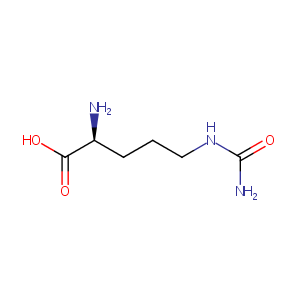Drug Information
| Drug General Information | Top | |||
|---|---|---|---|---|
| Drug ID |
D01XPY
|
|||
| Former ID |
DIB020199
|
|||
| Drug Name |
L-citrulline
|
|||
| Synonyms |
L-citrulline; citrulline; 372-75-8; H-cit-oh; delta-Ureidonorvaline; Sitrulline; N5-Carbamoyl-L-ornithine; L-Cytrulline; L(+)-citrulline; N5-(Aminocarbonyl)ornithine; N(delta)-Carbamylornithine; Citrulline, L-; alpha-Amino-delta-ureidovaleric acid; (S)-2-Amino-5-ureidopentanoic acid; N5-carbamoylornithine; d-ureidonorvaline; Ornithine, N5-(aminocarbonyl)-; L-2-Amino-5-ureidovaleric acid; L-Ornithine, N5-(aminocarbonyl)-; L-(+)-Citrulline; 2-Amino-5-ureidovaleric acid; L-citrullin; (2S)-2-amino-5-(carbamoylamino)pentanoic acid
Click to Show/Hide
|
|||
| Drug Type |
Small molecular drug
|
|||
| Indication | Acute lung injury [ICD-11: NB32.3; ICD-10: S27.3; ICD-9: 518] | Phase 3 | [1] | |
| Structure |
 |
Download2D MOL
|
||
| Formula |
C6H13N3O3
|
|||
| Canonical SMILES |
C(CC(C(=O)O)N)CNC(=O)N
|
|||
| InChI |
1S/C6H13N3O3/c7-4(5(10)11)2-1-3-9-6(8)12/h4H,1-3,7H2,(H,10,11)(H3,8,9,12)/t4-/m0/s1
|
|||
| InChIKey |
RHGKLRLOHDJJDR-BYPYZUCNSA-N
|
|||
| CAS Number |
CAS 372-75-8
|
|||
| PubChem Compound ID | ||||
| PubChem Substance ID |
3621, 821526, 824126, 3132518, 7886615, 8144684, 8157014, 11532235, 15195082, 15219582, 24892975, 26716699, 26754401, 29203971, 29228316, 46506583, 47291304, 50069751, 51092003, 57325798, 57580897, 57580924, 75891871, 81044522, 85164881, 87565504, 92297486, 92712847, 103590387, 103822856, 104179172, 104321397, 117541475, 117688788, 118262351, 124570894, 126523666, 126596840, 126596898, 126630014, 126656479, 129129178, 131542198, 132523304, 134974821, 135650512, 137003163, 137237572, 140948627, 142367638
|
|||
| ChEBI ID |
CHEBI:16349
|
|||
| Target and Pathway | Top | |||
|---|---|---|---|---|
| Target(s) | G-protein coupled receptor GPCR33 (GPRC6A) | Target Info | Agonist | [2] |
| References | Top | |||
|---|---|---|---|---|
| REF 1 | ClinicalTrials.gov (NCT02891837) L-citrulline for Prevention of Sequelae of Acute Lung Injury in Pediatrics Undergoing Cardiopulmonary Bypass for Heart Defects. U.S. National Institutes of Health. | |||
| REF 2 | Deorphanization of GPRC6A: a promiscuous L-alpha-amino acid receptor with preference for basic amino acids. Mol Pharmacol. 2005 Mar;67(3):589-97. | |||
If You Find Any Error in Data or Bug in Web Service, Please Kindly Report It to Dr. Zhou and Dr. Zhang.

